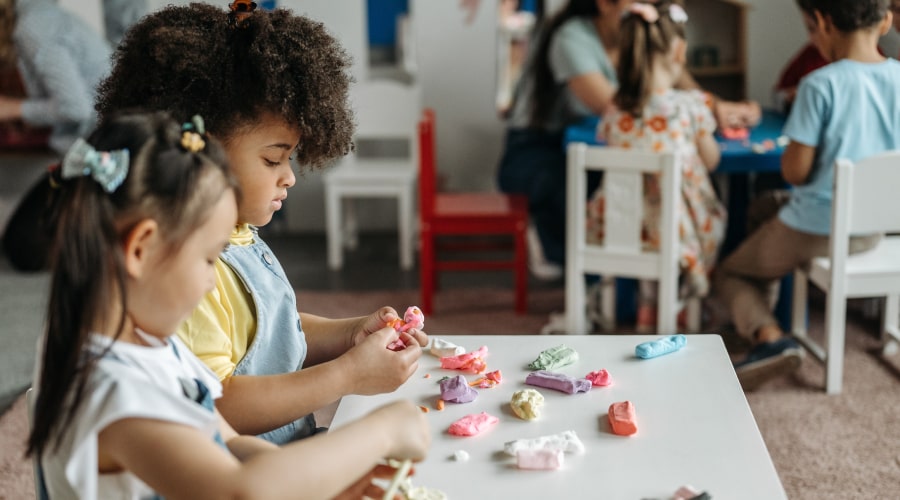settings
children
With Famly since
You’re sitting in front of the computer trying to find the best way to make glitter slime. But, to your utter dismay, there are about 1 million search results. There’s multi-coloured slime, organic slime, glow-in-the-dark slime, everything-in-your-cupboard slime.
Sometimes, there’s just too much information, and your brain feels like it’s about to explode - even if all you’re doing is searching for a pumpkin soup recipe. One the one hand, it’s great! Think about how many variations of soup à la pumpkin you could make. Yet when we start digging into some really important topics, like child development, it can get a little cloudy.
Is the Christmas activity you’re looking at grounded in any pedagogy? Is it for the benefit of the children? Who made it? What about the article you found on physical development? Is the information trustworthy? There’s a lot to think about, especially if you don’t even have 10 minutes in a day to scoff down a yogurt while the hustle and bustle of setting life goes on around you.
But taking the time to build your critical toolbox pays off in the long run, and once you’ve got the basics down you’ll be asking critical questions in your sleep. Read why building those critical skills is so important, and why a few minutes of extra scrolling goes a very long way to benefit the little ones.

Why be critical?
As an Early Years professional, your knowledge hub is overflowing with child development information, management expertise, time-management skills, nutritional expertise and so much more. That knowledge weaves the thread between a child’s home and their Early Years setting, and helps children in your care flourish. Which is exactly why thinking critically is so important.
We talk about fake news all the time, and a lot of us just laugh it off. There’s no way that the moon is covered in pink onions, and there aren’t aliens living underneath your fridge freezer. But when we look at fake news about political parties or vaccines, things can get messy. Say you read that someone in your local council did something awful, and now you’ll never vote for them because of that. In fact, you tell other people not to vote for them because of that awful thing. But what if that thing was actually a lie?
The same thing applies to pedagogy and teaching the little ones.
Picture this: you read a post about emotional development that said you should only ever tell children good things because they can’t handle the bad. Then for the next five years that’s exactly what you do. You don’t tell them any sad stories, even though that’s a big part of helping their development and empathy. And this then has a knock-on effect as they grow up.
As a practitioner, you have so much power in making sure pedagogy is taught with intent, with purpose and with a lot of expert knowledge. By asking a few questions here and there, you can make sure you and your staff are putting the children first and fighting the battle against wrong information.

First thing’s first - think twice
On an average day, we’re bombarded with information left, right and centre. You only have to turn on the TV for 5 minutes before you’ve seen 3 news stories, 12 adverts and a jingle for cat food that just won’t get out of your head. It’s too much for us to process all the time. So the very first step to building your critical toolbox is a simple one: think twice.
When you’re looking at the glitter and sparkle of TikTok videos and Pinterest boards, here are a few questions that’ll help you make sure your critical cap is on:
- Who made the post? Social media posts may come from a good place, but they’re just like a lot of other posts; they’re there to get likes. Just because something looks cool doesn’t mean it’s worth doing, even if it involves fairies and violet unicorns. And who made the post? Was it a childhood educator? Do they know why it’s beneficial for children? This is probably the most important question to ask yourself. Make sure it's someone you trust, and would take educational advice from if they were standing in front of you.
- Do I fully understand what I’m reading? Say you see an amazing article on activities to introduce a bit of Forest Schooling to your setting. The children would love them, but you’ve never introduced any Forest School ideas before. It’s a great idea to make sure you understand why these activities are a part of Forest Schooling, and what it means for the pedagogy before you introduce the activities.
- Is it fact or opinion? We all have opinions, and what might be very right for you might be questionable for someone else. Take the age-old debate about colouring sheets in the Early Years. Take a close look at the image or post. Do they give solid reasons? Or are they just raving about why colouring sheets are the best and you'd be completely crazy not to use them?
The big ideas
A note on social media
Social media is a fantastic way for practitioners to share their knowledge, so there's no need to quit cold turkey and start reading academic articles as your only source of information.
Just be mindful that anyone with a smartphone can upload anything to social media, and that doesn't make them an expert. If you are using social media to get inspiration on a new idea, like sensory play for instance, a good rule of thumb is to check the person's profile. Have a look at their other videos, who they are, and what kind of information they're putting out.
Social platforms let practitioners connect with other practitioners, and parents, in a heartbeat. It's also a hub of creative ideas and pedagogical practices - particularly those accounts that break down those big ideas into small chunks. It's just worth reminding yourself that everyone is on a learning journey. Don't be afraid to question the post, or reach out to the person who wrote it and ask for more information. Let's start a conversation, and be critical, together.
7 tips to start building your critical toolbox
Once you’ve asked yourself the three questions above, it’s time to start building those skills to put in your critical toolkit. It’s not an easy thing to do, so take it little by little. The most important thing to keep in mind is that your ethos and pedagogy should lie at the heart of what you take from online platforms.
It's so easy to feel overwhelmed and a little guilty if you see practitioners going to incredible lengths. But let's remember that a solid foundation is the most important thing. With that in mind, here are 7 tips to help you build your toolkit:

- Don’t use just one source. If you’ve found a video on home corners or self-regulation, and want to start introducing a few new concepts at your setting, shopping around is an excellent idea. Are there articles on it? What about your favourite educational sites? A trusted infographic from your local hospital?
- If it’s an activity for the children, it should benefit them. Placing the children at the heart of your decision is the best place to start. If you’re doing an activity just because it looks nice, it might be time to look for another activity altogether.
- Make sure you agree with it. Are you doing this activity because you think it’s a good idea, or because one of your members of staff thought it would be great as a display? Make sure you yourself agree with it, and that you aren’t compromising your own principles, or the principles of your setting.
- Ask your staff what they think. Discuss it with them, and hear each other’s opinion on the topic. Being critical together is a fantastic way to judge if the information fits with your setting, and if it's trustworthy.
- Ask yourself if it fits with your setting’s ethos. Is this activity or inspiration something that would fit in with your ethos, and the way you run your setting? If you’re an eco-friendly setting, for example, then using non-recyclable and non-reusable materials probably isn’t what you ideally want to start bringing in.
- Stay critical of huge online platforms. We all love a bit of instagram, TikTok and Pinterest. And they absolutely can be a source of information. As we mentioned, there's no need to swear off them forever. Just remember that thousands of posts go out every single minute, and you don't always know who made them.
- Use sources and websites you can trust. If you use sources you know you can trust, you’ll feel a little safer taking their word at face value. Think about websites that speak to education professionals, local authorities and local health websites.
If you’re looking for more information on why critical thinking is important, check out this handy guide here on how to develop those skills even further.
Top tips from Alphabet House
Get top tips from a setting just like yours. Hear from Alphabet House on why and how they use Famly - and why they’ve never looked back.
Read their story










